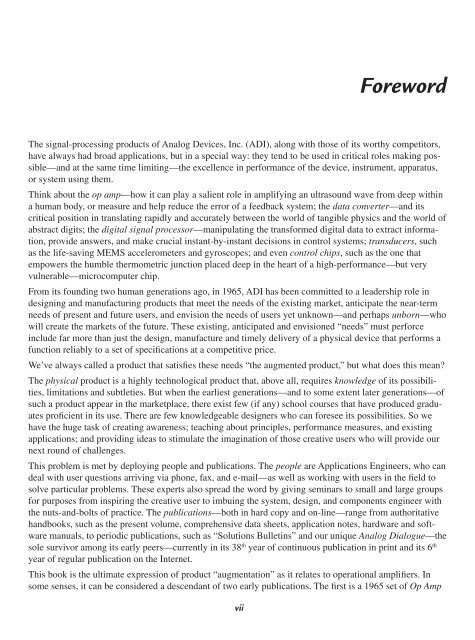Op Amp Applications Handbook Walt Jung, Editor
Op Amp Applications Handbook Walt Jung, Editor
Op Amp Applications Handbook Walt Jung, Editor
You also want an ePaper? Increase the reach of your titles
YUMPU automatically turns print PDFs into web optimized ePapers that Google loves.
vii<br />
Foreword<br />
The signal-processing products of Analog Devices, Inc. (ADI), along with those of its worthy competitors,<br />
have always had broad applications, but in a special way: they tend to be used in critical roles making possible—and<br />
at the same time limiting—the excellence in performance of the device, instrument, apparatus,<br />
or system using them.<br />
Think about the op amp—how it can play a salient role in amplifying an ultrasound wave from deep within<br />
a human body, or measure and help reduce the error of a feedback system; the data converter—and its<br />
critical position in translating rapidly and accurately between the world of tangible physics and the world of<br />
abstract digits; the digital signal processor—manipulating the transformed digital data to extract information,<br />
provide answers, and make crucial instant-by-instant decisions in control systems; transducers, such<br />
as the life-saving MEMS accelerometers and gyroscopes; and even control chips, such as the one that<br />
empowers the humble thermometric junction placed deep in the heart of a high-performance—but very<br />
vulnerable—microcomputer chip.<br />
From its founding two human generations ago, in 1965, ADI has been committed to a leadership role in<br />
designing and manufacturing products that meet the needs of the existing market, anticipate the near-term<br />
needs of present and future users, and envision the needs of users yet unknown—and perhaps unborn—who<br />
will create the markets of the future. These existing, anticipated and envisioned “needs” must perforce<br />
include far more than just the design, manufacture and timely delivery of a physical device that performs a<br />
function reliably to a set of specifi cations at a competitive price.<br />
We’ve always called a product that satisfi es these needs “the augmented product,” but what does this mean?<br />
The physical product is a highly technological product that, above all, requires knowledge of its possibilities,<br />
limitations and subtleties. But when the earliest generations—and to some extent later generations—of<br />
such a product appear in the marketplace, there exist few (if any) school courses that have produced graduates<br />
profi cient in its use. There are few knowledgeable designers who can foresee its possibilities. So we<br />
have the huge task of creating awareness; teaching about principles, performance measures, and existing<br />
applications; and providing ideas to stimulate the imagination of those creative users who will provide our<br />
next round of challenges.<br />
This problem is met by deploying people and publications. The people are <strong>Applications</strong> Engineers, who can<br />
deal with user questions arriving via phone, fax, and e-mail—as well as working with users in the fi eld to<br />
solve particular problems. These experts also spread the word by giving seminars to small and large groups<br />
for purposes from inspiring the creative user to imbuing the system, design, and components engineer with<br />
the nuts-and-bolts of practice. The publications—both in hard copy and on-line—range from authoritative<br />
handbooks, such as the present volume, comprehensive data sheets, application notes, hardware and software<br />
manuals, to periodic publications, such as “Solutions Bulletins” and our unique Analog Dialogue—the<br />
sole survivor among its early peers—currently in its 38th year of continuous publication in print and its 6th year of regular publication on the Internet.<br />
This book is the ultimate expression of product “augmentation” as it relates to operational amplifi ers. In<br />
some senses, it can be considered a descendant of two early publications. The fi rst is a 1965 set of <strong>Op</strong> <strong>Amp</strong>






